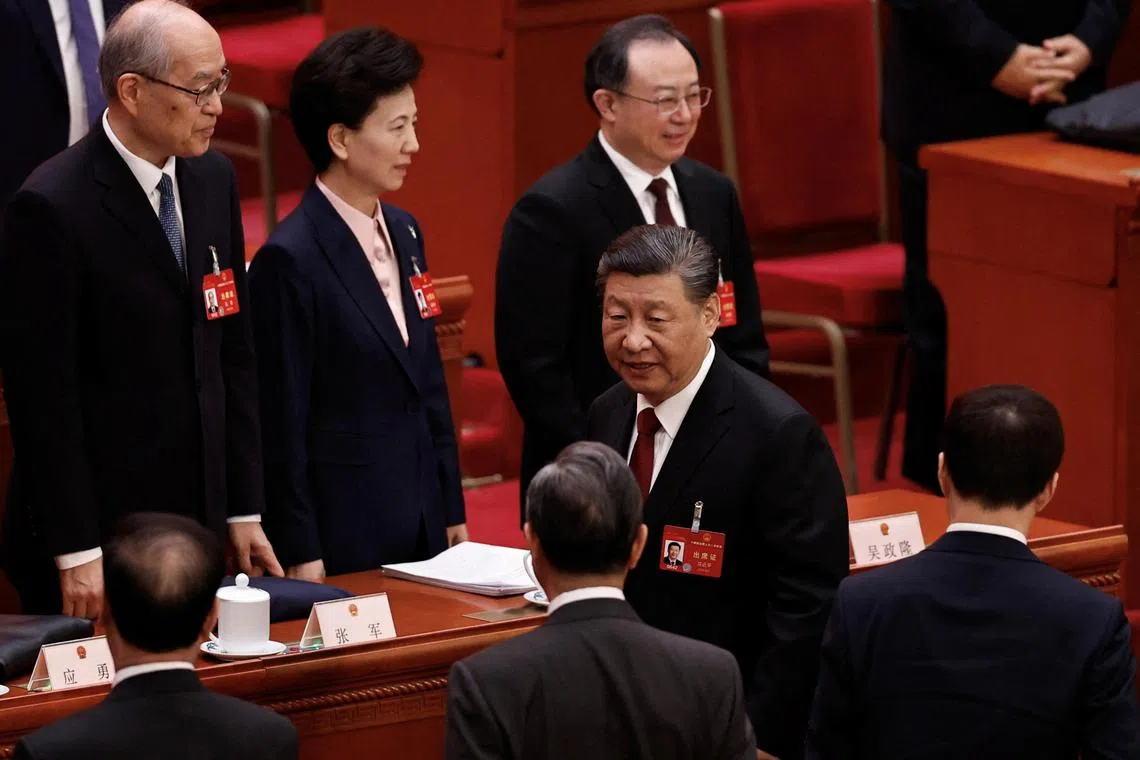Why China’s Xi Jinping is pushing ‘high-quality development’
Sign up now: Get insights on Asia's fast-moving developments

President Xi Jinping highlighted the importance of lifting productivity and improving the structure of the economy.
PHOTO: REUTERS
Follow topic:
BEIJING – When China’s economy was finally unshackled from the world’s strictest Covid-19 controls in late 2022, hopes were high that it would roar back to help power global growth. Instead, the country has faced a confluence of problems: a property crisis, flagging exports, sluggish consumer spending and towering local government debt.
The risk of a Japan-style deflationary malaise has led to an exodus of foreign capital, but President Xi Jinping has been unwilling to pull out the big stimulus guns.
Some of that reluctance stems from a desire to promote the high-tech and green industries of the future, and avoid another bout of unsustainable, debt-fuelled growth. A phrase that has cropped up in many of Mr Xi’s recent speeches seems to sum up his approach: “high-quality development”.
1. What does Xi mean by “high-quality development”?
The term is considered to underscore the quality of economic growth instead of the absolute pace.
When Mr Xi first used the term during a key party congress in 2017, he said China’s economy is transitioning away from a “high-speed growth phase”.
He highlighted the importance of lifting productivity and improving the structure of the economy, as he called for more efficient and sustainable development.
An analysis of Communist Party publications since then shows that progress in six key areas is often cited as required, including making the economy greener, more innovated and balanced.
2. Why does the phrase matter?
Key strategies put forward by Mr Xi underpin China’s economic and political policymaking.
Understanding the phrases he uses for those can offer insight into how Beijing intends to shape the world’s second-largest economy, from the intent to boost self-sufficiency with the “dual circulation” strategy to the focus on narrowing the wealth gap with the “common prosperity” push.
Mr Xi’s consolidation of power over the past decade means people hang on his words even more as decision-making can be more opaque, and investors are left to parse through party-speak for clues.
Mr Xi uttered the phrase on at least 128 occasions in 2023, nearly double the mentions of 2022 and his most annual uses on record. That reflects its growing importance.
It is also important because China has prioritised developing the economy and ensuring its fast growth in recent decades. A shift away from that could mean a fundamental change in the way officials are assessed, and government agencies are incentivised, which will inevitably have implications for growth.
3. How is it playing out so far?
It is difficult to give a definite answer because the concept is so broad.
In an attempt to develop a framework for assessing high-quality growth, the head of the Guangdong province’s statistics authority developed some 41 metrics to evaluate everything from pollution to financial risks.
In general, China has seen progress in some of the areas: The economy is increasingly powered by clean energy, and a push to develop advanced manufacturing and key technologies is bearing initial fruit. But other areas are seeing mixed results.
The effort to reduce the economy’s reliance on property and local government borrowing is still unfinished, but has already weighed on economic activities and consumer confidence.
Household income growth is still weak, and a measure of foreign investment into China turned negative for the first time.
4. Why are investors worried?
Downplaying the expansion pace of the economy could mean that policymakers are unwilling to roll out strong stimulus. That risks magnifying the problem of weak demand, fuelling fears over the possibility of “Japanification”, or China falling into a prolonged stagnation similar to what Japan experienced starting from the 1990s.
Deflation worries have already deepened as prices keep falling, making it less attractive for foreign firms to invest.
There is also concern the country’s shift towards high-value add manufacturing may further raise trade tensions.
Top officials including Premier Li Qiang stressed recently that they do not want to use massive stimulus that would boost short-term growth at the expense of risks to the future.
Indeed, as People’s Bank of China governor Pan Gongsheng warned, the transition of the economy towards a healthier model will be a “long and difficult journey”, which will be bad news for investors seeking quick gains.
China’s property market meltdown is an example of what happens when the government cracks down on debt-fuelled growth. It led to a wave of defaults and persistent declines in home prices, exacerbating pessimism among investors.
5. How bad has it got?
For foreign firms and investors, the business climate has deteriorated markedly in recent years.
Foreign companies appear less willing to re-invest profits made in the country, as tensions rise with the West and keeping cash overseas has become more attractive. A US$6 trillion (S$8 trillion) rout in China and Hong Kong stock markets shows the extent of pessimism.
Despite the need for bolder actions to counter deflation, the People’s Bank of China has stuck to its moderate approach towards rate cuts since the pandemic and relied on targeted easing – a strategy that has disappointed investors looking for more decisive moves.
Beijing argues that the economy will become more durable over the long term, buoyed by emerging competitive industries and sectors.
State media cites the country’s leading role in the production of electric vehicles, batteries, 5G telecommunications equipment, mobile payments and solar cells, saying China remains an attractive market for multinational companies. BLOOMBERG

